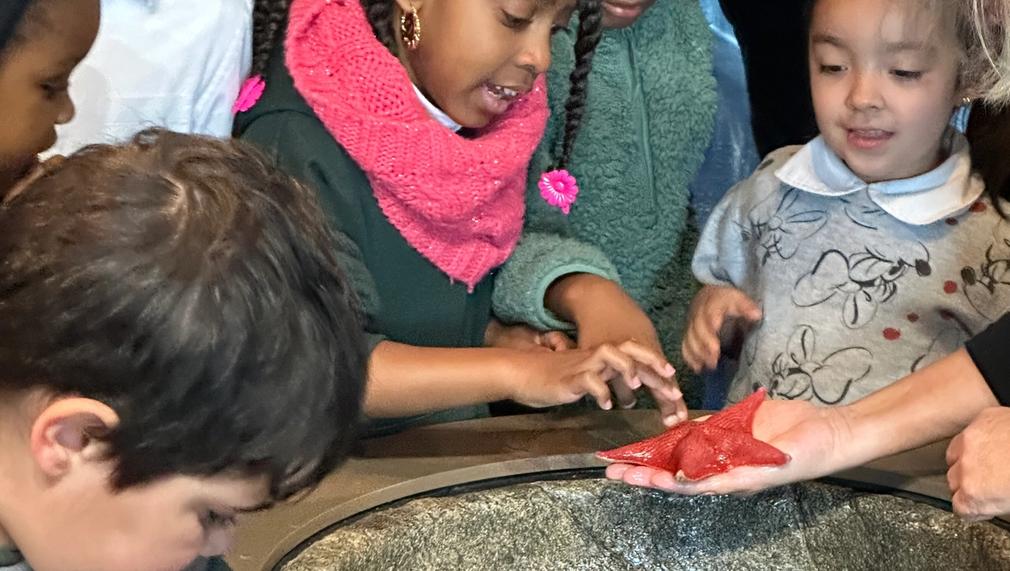DIVE into STEM
The DIVE into STEM (Developing Interest in Vital Environmental STEM) program will bring marine science and environmental education programs to over 25,000 students in grades K-12 at Title-1 schools in the Los Angeles region. Students will experience hands-on lessons with marine life at a field trip to the Roundhouse Aquarium, or as an outreach program to their school. Programs are customizable, NGSS-aligned and encourage development of critical thinking and problem-solving skills.

What is the primary issue area that your application will impact?
K-12 STEAM education
In what stage of innovation is this project, program, or initiative?
Expand existing project, program, or initiative (expanding and continuing ongoing, successful work)
What is your understanding of the issue that you are seeking to address?
A study by WestEd, Lawrence Hall of Science and SRI Intnl. showed that 40% of elementary teachers spend 1 hour or less teaching science each week and only 1/3 of teachers feel prepared to teach science. These teachers rely on field trips and classroom visits from outside experts to give their students the science and environmental education they need. As a result of a lack of early exposure, many students find science intimidating, difficult or unexciting. DIVE into STEM shows students that science is fun, engaging, exciting and can be done outdoors. Effective environmental education has been clearly shown to spark interest and higher performance in science learning (Campaign for Environmental Literacy, 2007). The underfunded schools in the LA area are the same schools that the National Science Board (NSB) has noted have the least experienced STEM teachers and the highest inequality in STEM education outcomes (NSB, 2022). These are the schools that will benefit from DIVE into STEM.
Describe the project, program, or initiative this grant will support to address the issue.
DIVE into STEM (Developing Interest in Vital Environmental STEM) will bring marine science and environmental education programs to over 20,000 students in Los Angeles County in grades K-12 at Title-1 schools. Students will experience hands-on lessons with marine life at a field trip to the Roundhouse Aquarium, or as an outreach program to their school, depending on school needs. All programs include free time to interact with our touch tank animals and specimens, time for students to ask our expert educators questions about any marine science topic, and grade level targeted discussions about the problem of marine pollution and becoming part of the solution. 2-hour field trips to the Roundhouse also include exploration time inside the aquarium to view all the tanks and displays, and time on the beach to further dive into pollution, learn about the process of erosion, and discover the importance of seaweed. Other activities are based on grade level, teacher requests, and student interests. These activities might include an interactive food chain lesson, plankton tow and microscope lesson, squid dissection, and more. While our lessons are flexible and can be adjusted to meet specific requests and needs, all programs are NGSS aligned and encourage development of critical thinking and problem-solving skills. This program will lead to an increase in exposure of students in grades K-12 to STEM and environmental education, and positive changes in attitudes about conservation.
Describe how Los Angeles County will be different if your work is successful.
We will increase student interest in science by immersing 20,000 students in ocean science. Our instructors come from diverse backgrounds (including women, minorities, and learning disabilities), and there are opportunities for students to see themselves and their interests in our instructors. We will show students that science is fun and can be based on any interest and done in any environment. We help to break the stereotypes that students may have as to who can be a scientist and what a scientist does. There will be an increase in the number of students interested in STEM fields after participating in the program. We hope to expand the program each year to reach new students and more schools in the Los Angeles area.
What evidence do you have that this project, program, or initiative is or will be successful, and how will you define and measure success?
This program is part of our larger Student Education Program, which has been educating students in the region for the past 45 years. Our programs have evolved to meet the needs of teachers and students across the decades, but we’ve always stayed true to our mission of marine and environmental science education. So far in 2024, we’ve reached over 12,000 students. While we’re waiting on some teacher and student surveys, we’ve found that for our on-site field trips 29% of participating students visited the beach for the first time ever on their DIVE into STEM field trip. Across both on-site field trip and outreach programs we saw a 10% increase in students interested in a career in science after the program. Overall, students from around the Los Angeles areas, particularly many marginalized communities, were able to experience hands-on marine and environmental science and developed a positive attitude about marine life, science, the ocean, and conservation in 2024 thanks to this program.
Approximately how many people will be impacted by this project, program, or initiative?
Direct Impact: 20,000.0
Indirect Impact: 20,000.0